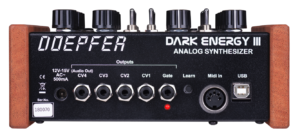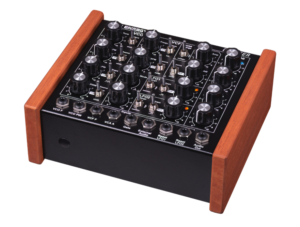Doepfer dives deeper into industry-standard Eurorack small-format modular system with quirky quintet of polyphonic modules
GRAEFELFING, GERMANY: having made musical waves during a show-stopping showcase of prototypes closer to home at SUPERBOOTH18 in Berlin, Germany, esteemed electronic musical device designer Doepfer is proud to globally announce availability of its A-111-4 Quad VCO, A-105-4 Quad Poly SSI VCF, A-132-8 Octal Poly VCA, A-141-4 Quad Poly VCADSR, and A-190-5 Polyphonic USB/Midi to CV/Gate Interface — a quirky quintet of polyphonic modules that sees the trailblazing company diving deeper into the now-industry-standard Eurorack small-format modular system standard that it initiated and popularised with its ever-expanding A-100 ANALOG MODULAR SYSTEM — as of March 1…
Who better to throw light on the thinking behind this quirky quintet than company CEO Dieter Doepfer himself. “Modular synthesizers are almost exclusively monophonic structures since true polyphonic patches require a lot of modules — at least four VCOs, four VCFs, four VCAs, and eight ADSRs for a ‘classic’ four-voice patch,” he begins. “But even then it’s difficult to control filter resonance or modulation depth of all the filters, for example, or the attack and decay time of all the envelope generators simultaneously. So now it’s possible to integrate these functions into the modular synth world with our polyphonic modules, though the idea is not just to recreate a standard polyphonic synth within the modular system but rather realise new polyphonic structures that go far beyond a standard polyphonic synth and also far beyond the typical monophonic structures of a modular system since they still offer access to all parameters via CV or gate.”
Getting going, then,

the A-111-4 Quad VCO module features four precision CEM3340-based — triangle core — VCOs (Voltage Controlled Oscillators), each with its own separate internal +/- power supply (to ensure stability and prevent unwanted VCO synchronisation). Each VCO has the same individual controls, and inputs/outputs, as follows: 1V/Octave CV In (Control Voltage input); +1 / 0 / -1 Octave switch; Tune control, with ~ 2 semitones / ~ 1 octave / ~ 4 octaves range selectable via internal jumpers; Mod. (modulation) CV In (Control Voltage input); Modulation Destination — upper position equals exponential frequency modulation (XM) and lower position equals linear frequency modulation (LM) or pulse-width modulation of the rectangle waveform (PM), selectable via internal jumper; frequency modulation (FM) or pulse- width modulation (PWM) of the rectangle waveform; Mod. Level (modulation intensity); triangle waveform output; sawtooth waveform output; rectangle waveform output — about 50% without external pulse-width modulation; SYC (sync) input — (CEM3340-type) hard or soft sync selectable via internal jumper; and minimum 10 octaves range (with appropriate external control voltage). Continuing further down its familiar (silver-grey) front panel, a Master section for all four VCOs includes the following controls and inputs/outputs: 1V/Octave CV In (Control Voltage input); +1 / 0 / -1 Octave switch; Tune control, with ~ 2 semitones / ~ 1 octave / ~ 4 octaves range selectable via internal jumpers; exponential frequency modulation (XM) CV In (Control Voltage input); triangle waveform sum output; sawtooth waveform sum output; and rectangle waveform sum output. Typical applications include: fat-sounding monophonic VCO with the ability to adjust any intervals; paraphonic patches — when working in combination with the A-190-5 Polyphonic USB/Midi to CV/Gate Interface and all four VCOs being processed by one VCF/VCA section; fully polyphonic patches — when working in combination with the A-190-5 Polyphonic USB/Midi to CV/Gate Interface and four complete VCF/VCA sections; complex VCO patches with up to four VCOs by means of the — exponential and linear — frequency modulation features and sync functions.

Following in (traditional subtractive synthesis) sequence, the A-105-4 Quad Poly SSI VCF module is Doepfer’s first polyphonic filter, featuring four identical 24dB lowpass (SSM2044-type) filters. The module itself includes the following controls and inputs/outputs: F (frequency); FM (frequency modulation) intensity; Q (resonance); audio input L (level); CVF (control voltage frequency) attenuator; CVFM (control voltage frequency modulation) attenuator; CVQ (control voltage resonance) attenuator; CVL (control voltage level) attenuator; CVF (control voltage frequency) socket; CVFM (control voltage frequency modulation) socket; CVQ (control voltage resonance) socket; CVL (control voltage level) socket; FM (frequency modulation) 1 – 4 sockets; audio In (input) 1 – 4 sockets; and audio Out (output) 1 – 4 sockets, so each filter features a separate FM input as well as an audio input and output. The FM input is typically connected to the output of the associated envelope generator, such as Doepfer’s A-141-4 Quad Poly VCADSR, while the envelope amount for all four filters is controlled by the FM knob and the CVFM input by four built-in VCAs, which are also controlled by the FM control and CVFM input to also allow voltage control of the envelope amounts. Additionally, it is also possible to apply frequency modulation to all four filters — for example, using an LFO (Low Frequency Oscillator) patched into the CVF socket and using the associated (CVF) attenuator. The range of the audio input level (L) control also allows clipping/ distortion with typical A-100 ANALOG MODULAR SYSTEM audio levels — from, for example, the A-141-4 Quad Poly VCADSR module — at the filter inputs. This parameter is also voltage controllable, as is the resonance (Q). Applications include polyphonic patches requiring four VCFs with the same parameters.

Perfectly named, the A-132-8 Octal Poly VCA module is an octal VCA (Voltage Controlled Amplifier), primarily primed for polyphonic applications. As such, it includes four pairs of VCAs — each pair including two daisy-chained VCAs, with one VCA having a linear control scale and the other a linear or exponential control scale, selectable via internal jumpers. Two VCAs are provided for each voice since one VCA is usually required for the loudness envelope and another for velocity (or other functions like individual voltage-controlled loudness of each voice, amplitude modulation, and so on). All VCAs are DC coupled and can be used in specialised applications and also for processing control voltages. The module features two Default Gain controls — GL and GX — that enable opening of the first four VCAs (L) and/or second four VCAs (X), with GL and GX generating two internal (0 – +10V) control voltages which are connected to the switching contacts of the 1L – 4L sockets (controlling GL) and 1X – 4X sockets (controlling GX). If no patch cable is inserted into the socket in question then the internal default (GL or GX) control voltage is used to control the corresponding VCA. This is necessary when the VCA in question is not in use — when no external control voltage is available, for instance, otherwise the VCA would close and there would be no output signal even if the other VCA in the chain is open. On the other hand, as soon as a patch cable is inserted into one of the CV Inputs then the corresponding internal default control voltage — CL or CX knob — is no longer used to control the VCA in question; rather an external control voltage patched to the CV Inputs now controls the level of the VCA in question. The GL and GX controls are also useful for testing polyphonic patches — tuning VCOs, for example.
Again, as implied by name,

the A-141-4 Quad Poly VCADSR module is a quad voltage-controlled envelope generator — again, primarily primed for polyphonic applications. As such, it features four ADSR-type voltage-controlled envelope generators with exponential curve shapes (charge/discharge curves of a capacitor). Common manual controls and CVA, CVD, CVS, and CVR inputs with corresponding polarizers are available for the attack (A), decay (D), sustain (S), and release (R) parameters. All four envelope generators have a gate input (G1 – G4), a control LED, and an envelope output (Out1 – Out4). Applications include polyphonic patches, such as four envelope generators with the same envelope parameters to control four VCFs, VCAs, or other modules.
Last, but by no means least, by providing four voices with a 1V/octave-standard CV Note (pitch control voltage) to control VCOs and a Gate output (to control envelope generators), alongside two additional (CV2 and CV3) control voltages, the appropriately-named

A-190-5 Polyphonic USB/Midi to CV/Gate Interface module does what it says on the tin. Those two additional control voltage outputs can be controlled by MIDI velocity, volume, modulation, pitch bend, aftertouch, or freely-assignable MIDI controllers. Multiple — four-voice monophonic (to control four monophonic voices by four successive MIDI channels); four-voice polyphonic (to control four monophonic voices by one MIDI channel) with several (rotating/non-rotating) sub-modes; two-voice polyphonic (to control two monophonic voices by one MIDI channel); and unison — modes are selected by switches with the result shown in the LCD. In play mode, for example, the LEDs of the first four switches display the gate states, while certain parameters of each mode can be edited.
Ending on a high note, Dieter Doepfer deduces, “Modular synthesizers will still be predominantly used for monophonic sounds, as I’m well aware, but at least one polyphonic sound appears in many pieces of music and now it’s possible to integrate this into the modular synth world with our polyphonic modules.”
Within Germany, the A-111-4 Quad VCO, A-105-4 Quad Poly SSI VCF, A-132-8 Octal Poly VCA, A-141-4 Quad Poly VCADSR, and A-190-5 Polyphonic USB/Midi to CV/Gate Interface modules can be ordered online from Doepfer directly (https://www.doepfer.de/form_e.htm) or via one of its German dealers (https://docs.doepfer.eu/en/dealer-germany/) for €400.00 EUR, €200.00 EUR, €160.00 EUR, €160.00 EUR, and €300.00 EUR, respectively.
Outside of Germany, the A-111-4 Quad VCO, A-105-4 Quad Poly SSI VCF, A-132-8 Octal Poly VCA, A-141-4 Quad Poly VCADSR, and A-190-5 Polyphonic USB/Midi to CV/Gate Interface modules can only be ordered from Doepfer dealers in the territories listed here: https://docs.doepfer.eu/en/ (Note that residents in countries without representation can, however, order from Doepfer directly.)
For more in-depth information, please visit the dedicated A-111-4 Quad VCO webpage here: https://www.doepfer.de/A1114.htm
For more in-depth information, please visit the dedicated A-105-4 Quad Poly SSI VCF webpage here: https://www.doepfer.de/a1054.htm
For more in-depth information, please visit the dedicated A-132-8 Octal Poly VCA webpage here: https://www.doepfer.de/a1328.htm
For more in-depth information, please visit the dedicated A-141-4 Quad Poly VCADSR webpage here: https://www.doepfer.de/a1414.htm
For more in-depth info, please visit the dedicated A-190-5 Polyphonic USB/Midi to CV/Gate Interface webpage here: https://www.doepfer.de/a1905.htm





